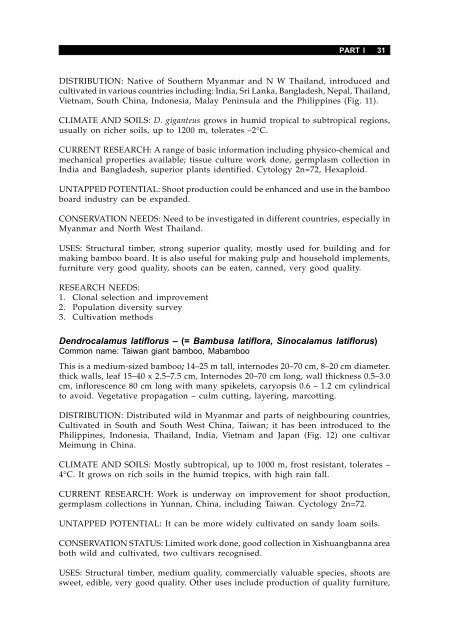Priority species of bamboo and rattan - Bioversity International
Priority species of bamboo and rattan - Bioversity International
Priority species of bamboo and rattan - Bioversity International
You also want an ePaper? Increase the reach of your titles
YUMPU automatically turns print PDFs into web optimized ePapers that Google loves.
DISTRIBUTION: Native <strong>of</strong> Southern Myanmar <strong>and</strong> N W Thail<strong>and</strong>, introduced <strong>and</strong><br />
cultivated in various countries including: India, Sri Lanka, Bangladesh, Nepal, Thail<strong>and</strong>,<br />
Vietnam, South China, Indonesia, Malay Peninsula <strong>and</strong> the Philippines (Fig. 11).<br />
CLIMATE AND SOILS: D. giganteus grows in humid tropical to subtropical regions,<br />
usually on richer soils, up to 1200 m, tolerates –2°C.<br />
CURRENT RESEARCH: A range <strong>of</strong> basic information including physico-chemical <strong>and</strong><br />
mechanical properties available; tissue culture work done, germplasm collection in<br />
India <strong>and</strong> Bangladesh, superior plants identified. Cytology 2n=72, Hexaploid.<br />
UNTAPPED POTENTIAL: Shoot production could be enhanced <strong>and</strong> use in the <strong>bamboo</strong><br />
board industry can be exp<strong>and</strong>ed.<br />
CONSERVATION NEEDS: Need to be investigated in different countries, especially in<br />
Myanmar <strong>and</strong> North West Thail<strong>and</strong>.<br />
USES: Structural timber, strong superior quality, mostly used for building <strong>and</strong> for<br />
making <strong>bamboo</strong> board. It is also useful for making pulp <strong>and</strong> household implements,<br />
furniture very good quality, shoots can be eaten, canned, very good quality.<br />
RESEARCH NEEDS:<br />
1. Clonal selection <strong>and</strong> improvement<br />
2. Population diversity survey<br />
3. Cultivation methods<br />
PART I 31<br />
Dendrocalamus latiflorus – (= Bambusa latiflora, Sinocalamus latiflorus)<br />
Common name: Taiwan giant <strong>bamboo</strong>, Ma<strong>bamboo</strong><br />
This is a medium-sized <strong>bamboo</strong>; 14–25 m tall, internodes 20–70 cm, 8–20 cm diameter.<br />
thick walls, leaf 15–40 x 2.5–7.5 cm, Internodes 20–70 cm long, wall thickness 0.5–3.0<br />
cm, inflorescence 80 cm long with many spikelets, caryopsis 0.6 – 1.2 cm cylindrical<br />
to avoid. Vegetative propagation – culm cutting, layering, marcotting.<br />
DISTRIBUTION: Distributed wild in Myanmar <strong>and</strong> parts <strong>of</strong> neighbouring countries,<br />
Cultivated in South <strong>and</strong> South West China, Taiwan; it has been introduced to the<br />
Philippines, Indonesia, Thail<strong>and</strong>, India, Vietnam <strong>and</strong> Japan (Fig. 12) one cultivar<br />
Meimung in China.<br />
CLIMATE AND SOILS: Mostly subtropical, up to 1000 m, frost resistant, tolerates –<br />
4°C. It grows on rich soils in the humid tropics, with high rain fall.<br />
CURRENT RESEARCH: Work is underway on improvement for shoot production,<br />
germplasm collections in Yunnan, China, including Taiwan. Cyctology 2n=72.<br />
UNTAPPED POTENTIAL: It can be more widely cultivated on s<strong>and</strong>y loam soils.<br />
CONSERVATION STATUS: Limited work done, good collection in Xishuangbanna area<br />
both wild <strong>and</strong> cultivated, two cultivars recognised.<br />
USES: Structural timber, medium quality, commercially valuable <strong>species</strong>, shoots are<br />
sweet, edible, very good quality. Other uses include production <strong>of</strong> quality furniture,

















